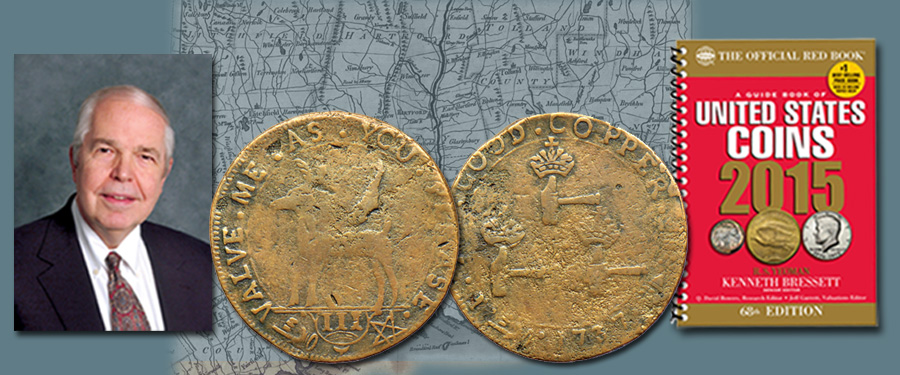
I continue my “tour” of the Guide Book of United States Coins. This week I am starting on page 48 so you can follow along. The subject is Higley coppers, not often called Granby coppers to my knowledge, but listed that way in the Guide Book. These are among the most interesting of all early American issues. They were made in copper, circa 1737 to 1739 by Dr. Samuel Higley of Granby, Connecticut, who held a degree in medicine from Yale College. He was a man of many activities, as he also practiced blacksmithing, made experiments in metallurgy, and some years earlier in 1727 devised a practical method for making steel from iron.
In 1728 he purchased property on a hill in Simsbury, the area later known as Granby, which furnished the site for many copper mines, the most famous being the extensive mine corridors and shafts which were later used as the Newgate Prison. Much information about this can be found on the Internet.
Mines on the hill were worked extensively during the early and middle 18th century. It was in October 1773 that the General Assembly passed an act to use certain of the old workings for prisoners, who were to be employed in mining with the profits going to the state. Actionable crimes included burglary, horse stealing, counterfeiting paper money, counterfeiting coins, or making dies or plates for doing so. Newgate Prison continued to be used until abandoned in 1827, by which time the buildings above ground had been destroyed by fire three times. The dark, damp conditions of underground precipitated many violent incidents, not unlike what one would read about the underground salt mines in Siberia.
After his 1728 land purchase, Higley opened his mining business and extracted exceptionally rich copper. Much if not most of the metal was shipped to England. Some time around 1737 he produced copper tokens, probably using his own copper, but this has not been verified. The obverse depicted a standing deer with the legend THE VALUE OF THREEPENCE. The reverse showed three crowned hammers (derived from the arms of the English blacksmith’s guild) with the surrounding legend, CONNECTICUT and the date 1737.
Legend tells us that drinks in the local tavern sold at the time for threepence each, and Higley was in the habit of paying with his own threepence coins. There seems to have been an objection to this, again according to folklore and tradition, as a copper threepence was of a diameter no larger than common English halfpence that circulated in the area at one-sixth of the value. Accordingly, Higley redesigned the coinage so that the obverse legend was changed to VALUE ME AS YOU PLEASE. Various other dies were made and are described in the Guide Book. While on a voyage to England in May 1737, with copper from his own mine, Dr. Higley died. His brother, John, together with Reverend Timothy Woodbridge and William Cradock, probably engraved and struck the issues of 1739. Facts are scarce, while numismatic tradition is strong.
The first authorized coinage to be made in Connecticut did not happen until years later in 1785 when there was a contract to produce copper coins that traded in circulation at the value of one cent, although they were the size of a British halfpenny. British halfpence also circulated at the value of one cent, especially after federal coin denominated ONE CENT were issued beginning in March 1793.
S.S. Crosby in his still useful The Early Coins of America, 1875, relates that a goldsmith that served his apprenticeship around 1810 said that Higley pieces were hard to find in circulation at the time and were in demand to use as an alloy for gold, as they were so pure. The goldsmith further related that his master delayed completing a string of gold beads for he was unable to find a copper Higley threepence to use as an alloy.
Today, Higley coins of all types are rare and usually come on the market only at widely spaced intervals, although in the past decade or so a number of important collections and offerings have been made.





